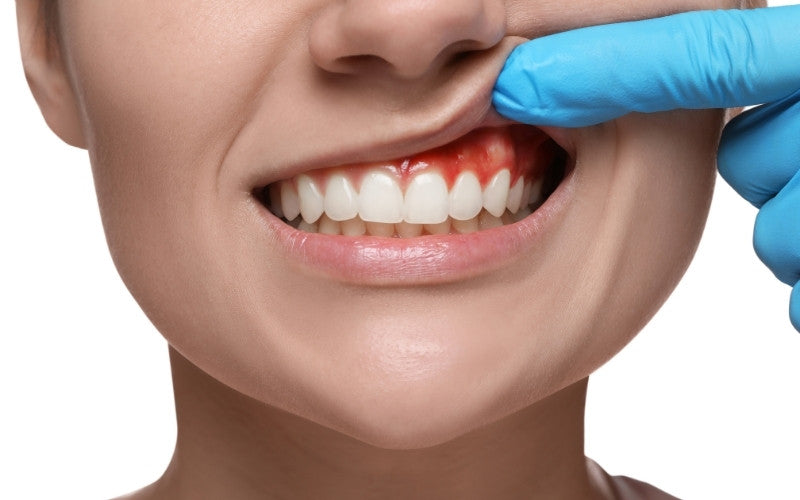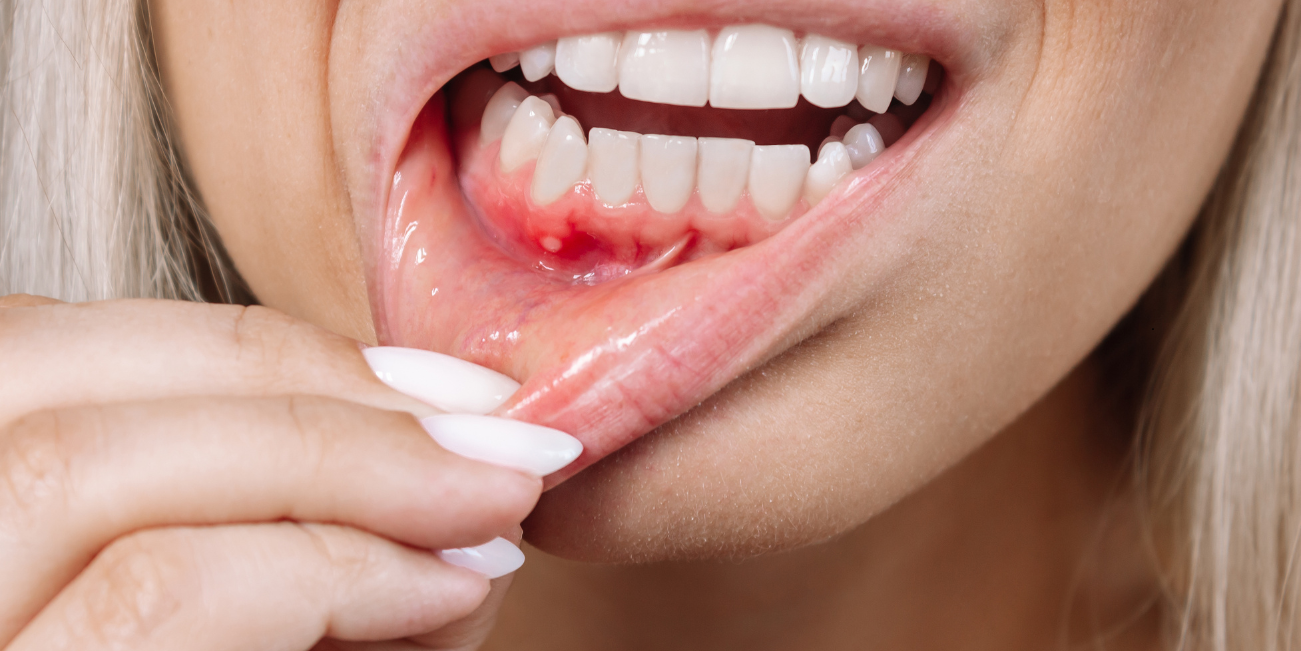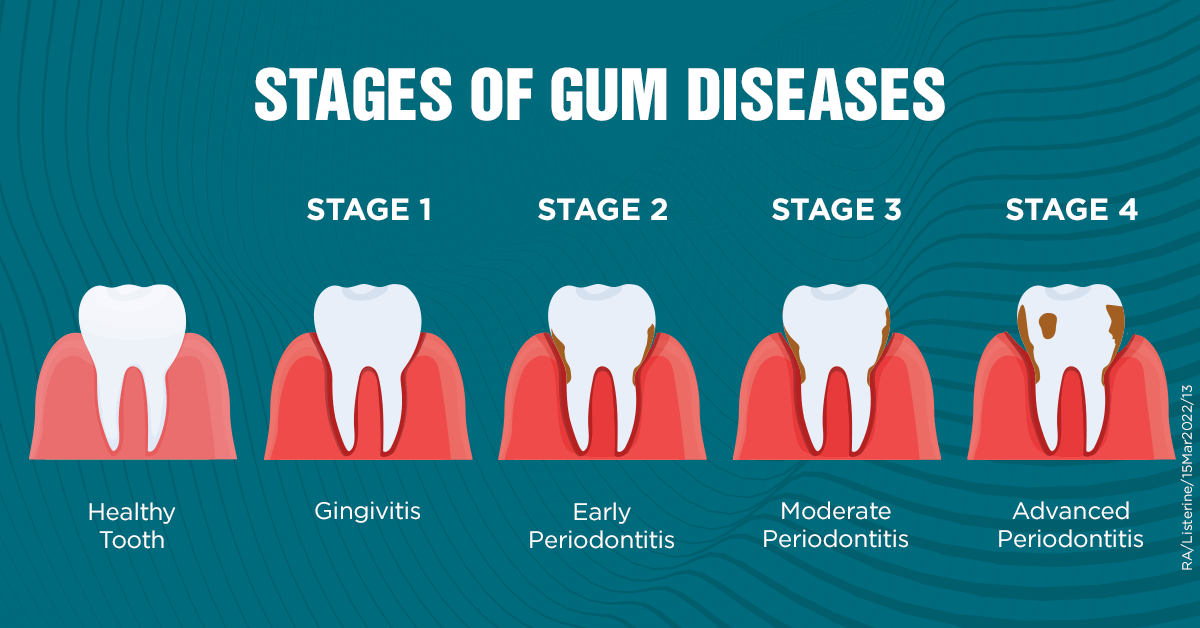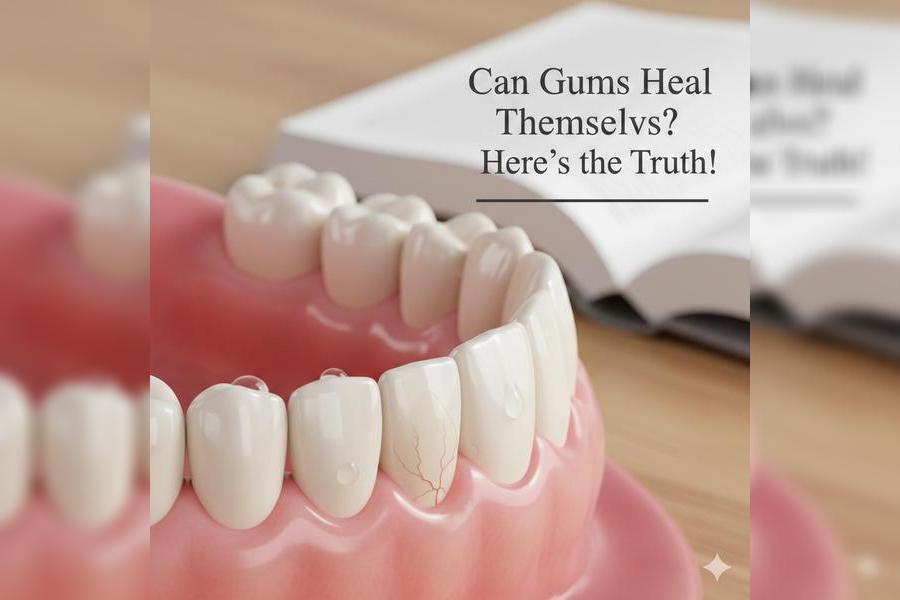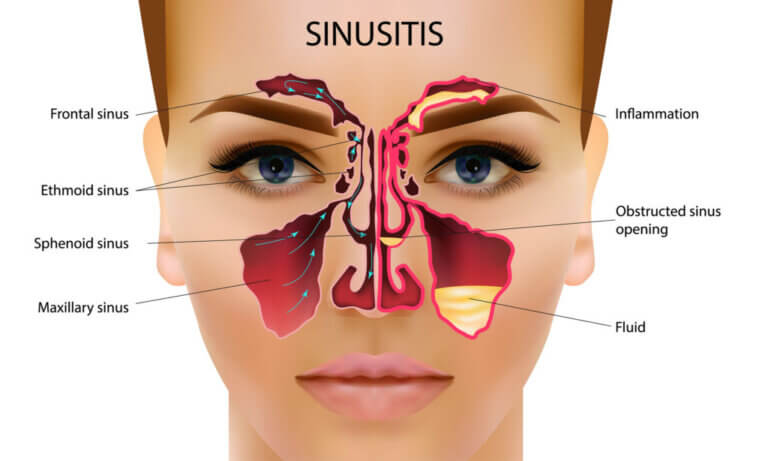You wake up - just like any other day and begin to brush your teeth, and suddenly. You jump with a jolt. Your gum stings and feels painful… You glare at the mirror and see that your once healthy pink gum has a white spot… and it hurts. And you wonder: Why is my gum white and painful?
This isn’t just a cosmetic issue. Your body may be sending you a red flag in the form of white and painful gums. Whether it is a simple nuisance like canker sores or more severe oral issues like gum disease, or even oral cancer, any variation in gum color and sensitivity is not to be overlooked.
The fact is that your gums speak of your general health condition. The pain, swelling or discoloration is not random but a sign. We will be digging deep into the meaning of those signals, potential causes, treatment options, and we will discuss how you can naturally take charge of your oral health - all in this article.
What Does It Mean When Your Gum Turns White and Painful?
When you realize that your gum is no longer its normal healthy pink color, is now white, sore, and painful, your body is making an attempt to tell you something.
Your gums are not only soft tissue that keeps your teeth in place but also a shield against bacteria, food particles, and infection. Once that barrier is weakened, the initial symptoms tend to present themselves in the form of color change, swelling, or pain.
Let’s break down what white and painful gums really mean.
Gum Discoloration Is Never Random
Normal gums are light pink and firm, occasionally with minor variations according to skin color. However, when your gums become white, pale, or patchy - it points to:
-
An infection (like gum disease).
-
Tissue trauma (from dental work, braces, or harsh brushing).
-
Immune response (autoimmune conditions such as lichen planus).
-
Precancerous changes (like leukoplakia).
Pain adds another layer to the picture. Painful white gums are an indicator that the tissue is either injured, inflamed, or being attacked by bacteria, fungi or your own body.
What White and Painful Gums Might Be Telling You
If you’re wondering why your gum is white and painful, here are some possible meanings behind the symptom:
-
Your Gum Is Battling an Infection: Oral conditions such as oral thrush or gingivitis may cause gum tissue to become pale or white in addition to becoming sore.
-
The Body is responding to stress or a lack of something: Canker sores tend to appear when you are feeling either tired, stressed or when you lack certain important vitamins. They seem to be white ulcers with red edges and yes..they hurt.
-
There is Trauma or Irritation: When you accidentally bite your gum, apply hard whitening strips or even brush too hard, that tissue can be damaged and turn white and painful.
-
Sign of a More Serious Warning: White spots that do not fade may be indicative of leukoplakia or oral cancer, and these are particularly concerning if you are a smoker or a frequent drinker. These need emergency dental care.
When Pain and Whiteness Happen Together
Sometimes, white pain-free gums are not harmful. Gums that are painful without any change in color could be just a case of irritation. However, when the two symptoms slap hands, i.e. white discolouration and pain, it is most likely that something bigger is occurring.
That is why dentists stress: do not disregard painful white gums. They are not merely a nuisance; your body is talking to you, saying: check me out.
The Bottom Line of This Section
When asking “What does it mean when my gum turns white and painful?” The answer ranges from minor issues like canker sores to more serious conditions like gum disease or oral cancer. The key takeaway? Any unexplained gum changes should be taken seriously. If the discomfort lingers beyond a week or worsens, scheduling a dental check-up is the safest step.
The Common Causes of White And Painful Gums

Once you realize that your gums are becoming white and sore, the reason might be negligible - or it can even be something that should be immediately attended to by a dentist. Knowing the underlying cause will allow you to do the right thing - be it basic home care or a medical consultation.
Let’s break down the most common culprits.
1. Canker Sores (Aphthous Ulcers)
The canker sores are painful, tiny, round ulcers which tend to develop inside your mouth, including your gums. They are normally white and yellow in the middle - and are brightly red at the border.
Why do they happen?
- Emotional stress.
- Vitamin deficiencies (B12, iron, folic acid).
- Less serious injuries (such as biting your gum by mistake).
-
Hormonal changes.
Symptoms:
- Pain or swelling around and on the sore.
- Redness in the middle of white patch.
-
Pain during the consumption of acidic or spicy food.
Good news: In the majority of cases, canker sores resolve on their own in a week or two, and do not require treatment. If they are painful, try saltwater, put on over-the-counter gels, or eat foods that do not irritate.
2. Oral Thrush (Fungal Infection)
Oral thrush occurs when Candida yeast proliferates in your mouth. It leaves white spots on gum, tongue, or cheeks - which can be wiped away occasionally leaving raw tissue underneath.
Risk factors include:
- Weakened immune system.
- Recent antibiotic use.
- Diabetes.
-
Wearing dentures.
Symptoms:
- White or creamy lesions on gums and tongue.
- Burning or soreness.
-
Difficulty swallowing.
Thrush may become contagious and severe if not treated. Antifungal medication may be prescribed by a dentist, yet good oral hygiene is also required.
3. Leukoplakia (Thick White Patches)
Leukoplakia is an appearance of thick, white spots on your gums or tongue, which cannot be scraped away. It is not always painful, but combined with gum irritation, it can result in tenderness.
Major risk factors:
- Smoking.
- Chewing tobacco.
-
Heavy alcohol use.
Why it matters: Although leukoplakia is not really cancer, it may sometimes progress to oral cancer. White gum patches that are recurrent should always be evaluated by a professional.
4. Gum Disease (Gingivitis and Periodontitis)
Gum disease is one of the most widespread responses to the question of Why is my gum white and painful?
-
Gingivitis: The initial period, characterized by bleeding, swollen gums which can appear pale or white at times.
-
Periodontitis: The severe form in which gums recede, bleed easily, and teeth become loose.
Key symptoms:
-
Gum tenderness and bleeding.
-
Bad breath that won’t go away.
-
Gum tissue becomes pale or patchy white.
-
Tooth sensitivity.
A natural gum solution can help here. The Goodbye Company Gum Disease oral solution has Omega 3 and 9 oils, as well as neem and clove essential oils, which are scientifically known to possess anti-inflammatory, antibacterial, and healing properties. In case you have bleeding gums, sensitivity, or constant pain, including this product in your arsenal will help maintain healthy gums and prevent the progression of the disease.
5. Oral Lichen Planus (Autoimmune Response)
This chronic condition creates white, lace-like patches on gums and cheeks. It’s caused by the immune system mistakenly attacking mouth tissue.
Symptoms:
-
White streaks or patches inside the mouth.
-
Burning pain when eating spicy or acidic food.
-
Possible red, swollen gums.
It’s not contagious, but it can be long-lasting and requires ongoing management with a dentist.
6. Oral Cancer Warning Signs
While rare, oral cancer sometimes begins with a persistent white or red patch on the gum tissue. Unlike canker sores, which heal within weeks, oral cancer lesions don’t go away on their own.
Warning signs include:
- White or red patches that last more than 2 weeks.
- Unexplained bleeding or gum swelling.
- Persistent jaw pain or loose teeth.
-
A sore that doesn’t heal.
If you notice these symptoms, see a dentist or oral surgeon immediately. Early detection can save lives.
Comparing Common Causes of White and Painful Gums
|
Condition |
Appearance |
Pain Level |
Risk Factors |
Treatment |
|
Canker Sores |
Small white/yellow ulcers |
High |
Stress, trauma, vitamin deficiency |
Heals in 1–2 weeks, OTC gels |
|
Oral Thrush |
White creamy patches |
Moderate |
Diabetes, antibiotics, weak immunity |
Antifungal meds, oral rinse |
|
Leukoplakia |
Thick white patches |
Low–Moderate |
Smoking, alcohol |
Biopsy, lifestyle changes |
|
Gum Disease |
Swollen white/red gums |
Moderate–High |
Poor hygiene, smoking |
Professional cleaning, gum care |
|
Lichen Planus |
White lace-like lines |
Moderate |
Autoimmune disorders |
Corticosteroid mouth rinse |
|
Oral Cancer |
White/red persistent sores |
Variable |
Tobacco, alcohol, HPV |
Surgery, radiation, chemo |
How to Relieve Pain And Treat White Gums at Home

When you’re asking yourself, “Why is my gum white and painful?”, the next question that naturally follows is: “What can I do about it right now?” Gum pain and discoloration can make eating, drinking, and even brushing your teeth miserable. The good news? There are several effective home remedies and treatments that can bring you relief while also supporting long-term gum health.
Quick Soothing Remedies for Immediate Relief
1. Saltwater Rinse
One of the oldest and most reliable remedies is rinsing with warm saltwater. Salt acts as a natural antiseptic, helping reduce oral bacteria and soothing inflamed tissue.
-
Mix ½ teaspoon of salt in a glass of warm water.
-
Swish gently for 30 seconds, then spit out.
-
Repeat 2–3 times a day.
This can help calm pain from canker sores, gum irritation, and early gum disease.
2. Cold Compress
If your gums feel swollen and painful, applying a cold compress to the outside of your cheek can reduce inflammation. The cooling effect numbs nerve endings, bringing temporary pain relief.
3. Aloe Vera Gel
Known for its anti-inflammatory and healing properties, aloe vera can be applied directly to the gums. It works especially well for burning sensations caused by ulcers or oral lichen planus.
Natural Antimicrobial Solutions
4. Oil Pulling
An ancient Ayurvedic practice, oil pulling involves swishing coconut oil or sesame oil in your mouth for 10–15 minutes. This helps reduce harmful bacteria and plaque that can make gum pain worse.
5. Clove Oil
Clove has been used for centuries as a natural pain reliever thanks to its compound eugenol. Applying diluted clove oil to sore gums can temporarily numb discomfort while also fighting bacteria.
Strengthening Gums For Long-Term Health
Relieving pain is important, but the real key is addressing the root cause of why your gum is white and painful in the first place. That means strengthening gum tissue and reducing inflammation.
6. Improve Oral Hygiene
-
Brush twice daily with a soft-bristled toothbrush.
-
Floss carefully to remove plaque buildup.
- Avoid harsh mouthwashes that contain alcohol, which can dry out gums.
7. Stay Hydrated
Dry mouth contributes to oral thrush, gum irritation, and ulcers. Drinking enough water helps keep your gums moist and supports saliva flow, which is your body’s natural defense against bacteria.
A Natural Boost: The Goodbye Company Gum Disease
If you’re dealing with white, painful gums caused by gingivitis or poor oral health, incorporating a natural product can make all the difference.
The Goodbye Company Gum Disease is not just a preventative solution - it actively supports healing. Infused with Omega 3 and 9 oils as well as neem and clove essential oils, it works in three powerful ways:
-
Anti-inflammatory action → Reduces swelling and gum tenderness.
-
Antibacterial protection → Helps eliminate harmful bacteria that cause gum disease.
-
Tissue healing support → Promotes faster recovery for bleeding or sensitive gums.
Unlike harsh chemical rinses, it’s gentle, natural, and safe for daily use. If you currently suffer from bleeding gums, tooth sensitivity, or recurring gum pain, adding this product to your routine can be the game-changer your mouth needs.
When Home Remedies Are Not Enough
Home treatments can bring comfort and even stop early irritation, but if your white gums persist longer than 1–2 weeks, or the pain keeps returning, it’s time for a professional check-up. Some conditions, like oral thrush, leukoplakia, or oral cancer, require targeted medical treatment.
When to See a Dentist Immediately
Seek professional care if you notice:
-
White patches lasting over 2 weeks.
-
Pain that worsens instead of improving.
-
Gum bleeding that doesn’t stop.
-
Loose teeth.
- Unexplained swelling in jaw or lymph nodes.
Preventing White And Painful Gums

When you find yourself asking, “why is my gum white and painful?” prevention is often just as important as treatment. White patches, gum irritation, and oral discomfort usually don’t appear overnight; they’re the result of small habits (or neglect) building up over time. The good news? With the right oral care routine and lifestyle adjustments, you can significantly reduce your risk of painful white gums.
1. Stick to a Strong Oral Hygiene Routine
One of the most effective ways to avoid gum disease, gum infections, and oral thrush is to consistently clean your mouth. Poor oral hygiene leads to plaque buildup, which irritates gum tissue and triggers inflammation.
-
Brush twice daily with a soft-bristle toothbrush.
-
Floss at least once a day to remove food particles and bacteria hiding between teeth.
- Use an antibacterial mouth rinse to help reduce oral bacteria that cause gum irritation.
2. Strengthen Gums with the Right Nutrition
Your diet directly affects your gum health. A lack of nutrients can weaken your body’s defense against infections that cause white patches and gum pain.
-
Vitamin C helps maintain collagen in gums, keeping them firm and resistant.
-
Vitamin D and calcium strengthen teeth and bones.
-
Omega-3 fatty acids are powerful anti-inflammatories that soothe gum tissue.
This is where The Goodbye Company Gum Disease product fits beautifully - it’s infused with Omega 3 and 9 oils, plus neem and clove essential oils, all known for reducing inflammation, fighting bacteria, and supporting long-term gum health. Adding this natural solution to your daily oral care routine doesn’t just protect against gingivitis; it actively strengthens your gums against future irritation.
3. Avoid Lifestyle Habits That Damage Gums
Some habits make you more prone to painful and discolored gums:
-
Smoking – slows healing, weakens blood flow, and increases oral thrush risk.
-
Excess alcohol – dries out the mouth, allowing bacteria to thrive.
-
Stress – lowers immunity, making infections like oral candidiasis (fungal infections) more likely.
Breaking these habits is essential if you want to prevent asking yourself later: why is my gum white and painful again?
4. Schedule Regular Dental Visits
Even if you maintain oral hygiene at home, regular dental check-ups are crucial. A dentist can detect early signs of leukoplakia, oral lichen planus, gum infections, or pre-cancerous changes before they progress into something painful.
-
Aim for cleanings every 6 months.
- Get evaluated if you notice persistent white patches, gum sensitivity, or bleeding.
5. Natural Preventative Care for Long-Term Gum Health
Beyond brushing and flossing, there’s a growing emphasis on natural gum care solutions. Many patients now prefer alternatives to chemical-heavy oral rinses.
That’s exactly where The Goodbye Company Gum Disease stands out. The blend of neem and clove essential oils has been used for centuries to treat oral infections and soothe pain. Combined with Omega oils, it works as a preventative and restorative remedy - making it one of the best natural options to stop gum pain before it starts.
FAQs - Why is My Gum White And Painful
Why are my gums white and sore in one spot?
This could be a canker sore, oral thrush patch, or early gum disease localized in one area. If it persists beyond 2 weeks, see a dentist.
Can stress cause white gums?
Yes. Stress weakens the immune system, making you more prone to canker sores and oral infections.
Are white gums a sign of cancer?
Not always, but persistent white patches or painful sores should be evaluated for oral cancer - especially if you smoke or drink alcohol.
How long does it take for white gums to heal?
Depends on the cause:
-
Canker sores: 1–2 weeks.
-
Oral thrush: Clears with antifungal treatment in days.
- Gum disease: Requires professional cleaning and ongoing care.
How do you treat white gums naturally?
Aside from rinsing with saltwater and maintaining good oral hygiene, adding The Goodbye Company Gum Disease oral solution to your daily routine offers natural healing benefits.
Outlook
If you’re wondering “Why is my gum white and painful?” The answer could range from a minor sore to a serious oral health condition. The key is not to ignore the signs.
-
For mild irritation, home remedies can help.
-
For infections or gum disease, treatment is necessary.
-
For persistent or suspicious white patches, a dental check-up is essential.
And for those seeking a natural solution, The Goodbye Company Gum Disease oral solution offers a holistic approach to gum care, combining Omega oils, neem, and clove to prevent and heal gum issues naturally.
Take control of your oral health today - because your smile deserves more than just quick fixes.


